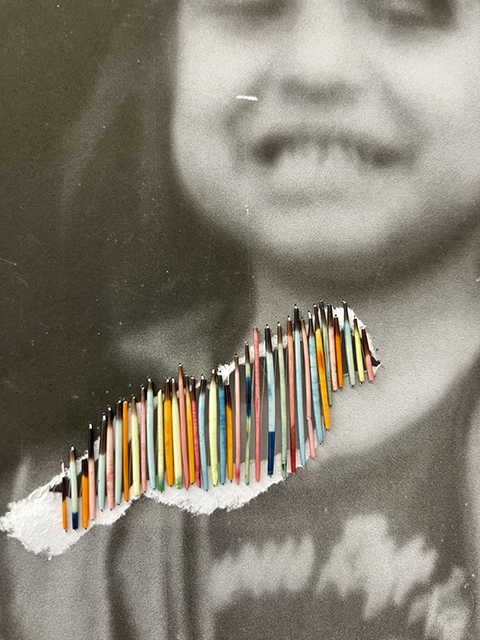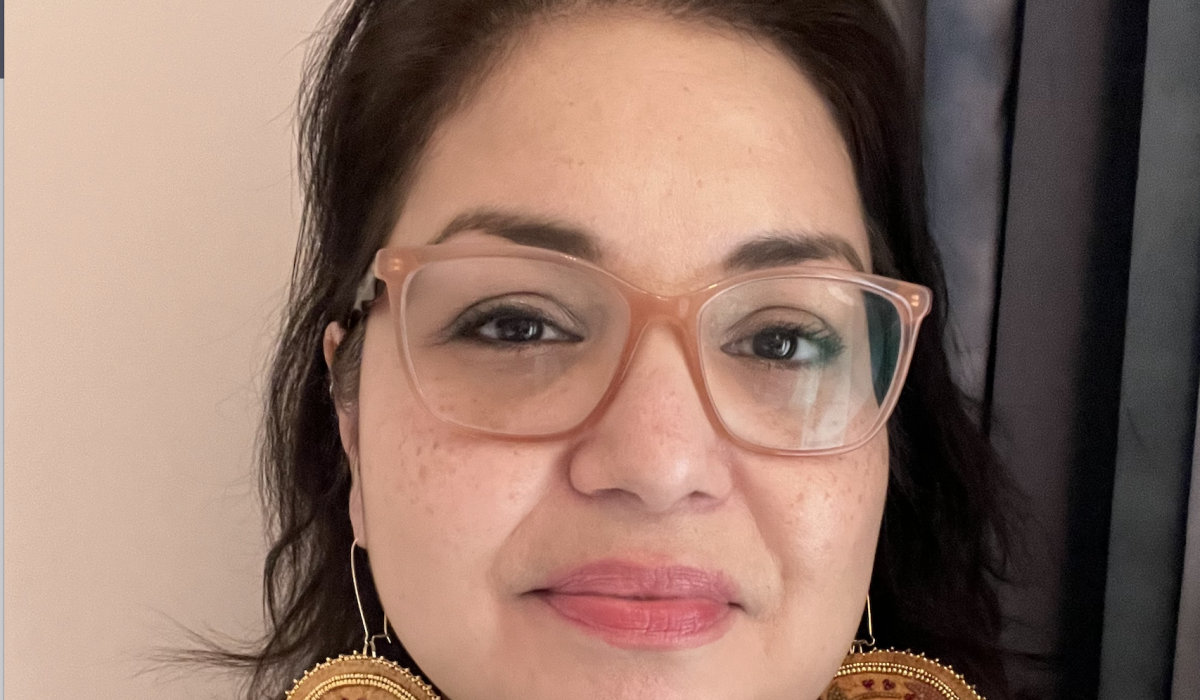Multidisciplinary visual artist Michelle Sound (Cree and Métis) brings drum making, caribou hair tufting, photography, painting and beading to her art making, carving a path deeply rooted in her personal heritage and experiences.
Sound has been busy this spring and summer, participating in multiple exhibitions across Canada. These include Land Breaths A Treaty 8 Exhibition at the Art Gallery of Grande Prairie in Alberta, the BACA Biennial in Montreal, and Otherwise Disregarded, a show at the Audain Art Museum in Whistler, B.C.
“It’s been nonstop,” Sound said.
Despite the demands of her schedule, Sound finds joy in the diversity of these group shows.
“They were all these really big group shows, which was nice,” she said.
The variety of venues, from city galleries to larger institutions, has been particularly rewarding for Sound as an artist.

Sound’s family is from Wapsewsipi Swan River First Nation on her mother’s side, and Buffalo Lake and Kikino Métis settlements on her father’s. Born and raised in Vancouver on the unceded ancestral territories of the Squamish, Tsleil-Waututh, and Musqueam Nations, Sound’s artistic journey reflects her connections to Treaty 6 and Treaty 8 territories.
“I think I’ve always been an artist,” Sound said. “But I didn’t think being an artist was a job.”
Initially pursuing art history, the pull towards visual arts had her transferring, and earning both a bachelor of fine arts from British Columbia’s Simon Fraser University and a master of fine arts from Emily Carr University of Art + Design in Vancouver.
Despite her early passion for drawing, Sound grew up thinking that a career in art was somehow far-fetched, possibly due to a lack of artist role models growing up.
“I didn’t know any artists,” she said.
Sound’s work springs from the relationship between personal history and artistic expression. Her pieces often draw on her family’s experiences, challenging the notion that art should be universal and impersonal.
“I was told a lot in art school to not make it personal,” she said. “But I decided I really wanted to make it about my family, and what our family had experienced.”
This decision has led to powerful works that resonate deeply with audiences, particularly Indigenous viewers who see their own stories reflected in her art.
In Sipikiskisiw (Remembers Far Back) there are maps of stolen land, torn images of community members, mended with colourful beading and quillwork. In some work, there are family photos, similarly torn with gaps filled with hand stitching. Seeing Nehiyaw (Cree) words with sections ripped out, the emphasis is clear.
The rips represent colonial violence including residential school, intergenerational trauma, loss of language and displacement.
The gaps left are what Sound is looking directly into, and creating art in that space.
“The ripped pieces I was working with, especially the family images are obviously much harder,” she said. “And so, I found with those ones, I had a different experience of working that I’d never had happen before. I started to talk to the pieces, talk to the people that were in them, sometimes apologize.
“With some of the “Holding it together” pieces, I felt like I was working with and collaborating with people who had passed on.”
This connection to her subjects goes beyond representation. Sound explained it is about ensuring that their stories are told with respect and authenticity.
Sound sees artists as “recorders of history,” whose work may not be fully appreciated in their own time. “I feel like we play such an important role, but often an overlooked role,” she said. “It’s not until years later that people realize that was exactly what was happening.”
This belief in the enduring impact of art motivates Sound to create works that are not just “pretty,” or aesthetically pleasing, but also historically significant.
“Sometimes people will say, ‘It’s so pretty, or these colours are so nice,’” she said. “But it goes much deeper than that. The work is about these really hard truths that I think a lot of Canadians still don’t know about or aren’t trying to learn.”
It’s not always explicitly in the work, but some of Sound’s art is “very much about residential schools and Canadian policy and the Indian Act. And that might not be what people think about when they see it because they see an individual or a family. But it’s how all of those things affected us and continue to have long-term effects.”
Sound’s commitment to honouring her family’s history is evident in the care she takes with these works. “I really wanted to make it personal, to honour my ancestors and what they went through,” she said.
Creating such personal art does bring a heavier emotional weight Sound explained, particularly when using images of her family members who have passed away.
“Every photo I have of my mother,” is a series of cyanotype (sun printed) drums featuring images of her mother, who passed away at a young age. Sound described hurdles in bringing these images to life.
Her mother’s face often failed to appear in the final prints. “The cyanotype would turn out perfect, everything would be there,” she said. “And then, when I’d rinse it off, my mom’s face would disappear from it – just her face.”
Sound said she would talk to her mother as she worked, explaining her intentions for the pieces while playing music her mother loved, like Janis Joplin. “And then her face started to show up,” Sound said.
“I know there’s people who don’t like to work with images of people that have passed away. But I was kind of like, it’s my mom, this is fine.”
This shift has added a new dimension to her creative process, making it not just an act of creation, but also one of communication and healing.
Sound said people are very drawn to the images of her mother.
“She just had such a strong presence for such a little girl,” she said. “She wasn’t cutesy smiling for the camera or posing or shy in any way. She was very directly intensely staring at the camera, and therefore the viewer.”
Sound is currently working on a series of banners of text and rabbit fur, using quotes from her mom, kokum and her aunt who raised her.
“’One tough cookie,’ is something they would say all the time,” Sound said. “That idea of these tough, strong Indigenous women is something I want to explore more, just celebrating that for them. They were tough and they were cool.”
Sound acknowledged the transformative power of her work, both for herself and for those who view it. By making her art deeply personal, she has found a way to connect with others on a profound level.
Sound is not just preserving her family’s history, but also creating a space for others to see themselves and their own stories reflected in her work.
“You can respond to an individual story more than you can to facts on the wall,” she said.
______
Current and upcoming shows:
It begins with knowing and not knowing, Richmond Art Gallery, July to Sept.
Creation Stories: Supernatural, Saint-Hyacinthe Exhibition Center, June 8 to Sept. 8.
Otherwise Disregarded, Audain Art Museum, Whistler, Apr. to Sept.
shnu’a’th, ᐊᑳᒥᕽ akâmihk, the other side – with Eliot White-Hill. Nanaimo Art Gallery, Oct.
Infinite Forms, Centre d’exposition de l’Université de Montréal. Nov. to Jan. 2025.

